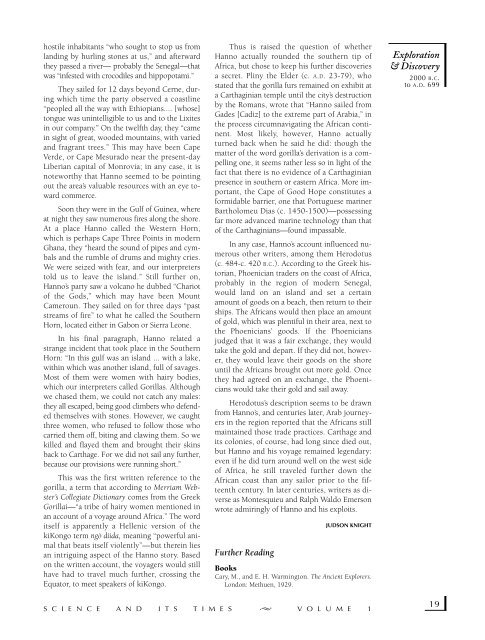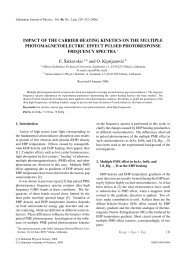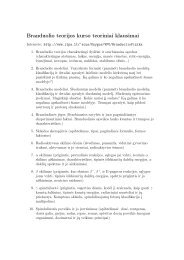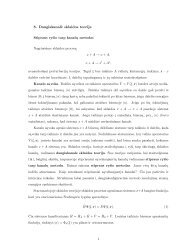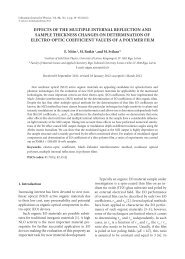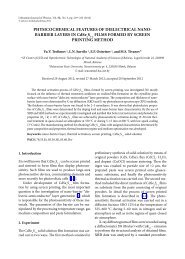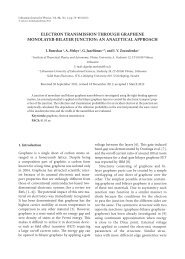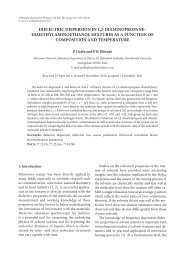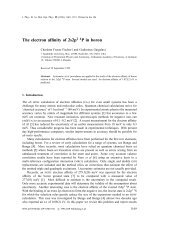Gale - Science and Its Times Vol 01 (2000 BC to AD 699).pdf
Gale - Science and Its Times Vol 01 (2000 BC to AD 699).pdf
Gale - Science and Its Times Vol 01 (2000 BC to AD 699).pdf
You also want an ePaper? Increase the reach of your titles
YUMPU automatically turns print PDFs into web optimized ePapers that Google loves.
hostile inhabitants “who sought <strong>to</strong> s<strong>to</strong>p us from<br />
l<strong>and</strong>ing by hurling s<strong>to</strong>nes at us,” <strong>and</strong> afterward<br />
they passed a river— probably the Senegal—that<br />
was “infested with crocodiles <strong>and</strong> hippopotami.”<br />
They sailed for 12 days beyond Cerne, during<br />
which time the party observed a coastline<br />
“peopled all the way with Ethiopians.... [whose]<br />
<strong>to</strong>ngue was unintelligible <strong>to</strong> us <strong>and</strong> <strong>to</strong> the Lixites<br />
in our company.” On the twelfth day, they “came<br />
in sight of great, wooded mountains, with varied<br />
<strong>and</strong> fragrant trees.” This may have been Cape<br />
Verde, or Cape Mesurado near the present-day<br />
Liberian capital of Monrovia; in any case, it is<br />
noteworthy that Hanno seemed <strong>to</strong> be pointing<br />
out the area’s valuable resources with an eye <strong>to</strong>ward<br />
commerce.<br />
Soon they were in the Gulf of Guinea, where<br />
at night they saw numerous fires along the shore.<br />
At a place Hanno called the Western Horn,<br />
which is perhaps Cape Three Points in modern<br />
Ghana, they “heard the sound of pipes <strong>and</strong> cymbals<br />
<strong>and</strong> the rumble of drums <strong>and</strong> mighty cries.<br />
We were seized with fear, <strong>and</strong> our interpreters<br />
<strong>to</strong>ld us <strong>to</strong> leave the isl<strong>and</strong>.” Still further on,<br />
Hanno’s party saw a volcano he dubbed “Chariot<br />
of the Gods,” which may have been Mount<br />
Cameroun. They sailed on for three days “past<br />
streams of fire” <strong>to</strong> what he called the Southern<br />
Horn, located either in Gabon or Sierra Leone.<br />
In his final paragraph, Hanno related a<br />
strange incident that <strong>to</strong>ok place in the Southern<br />
Horn: “In this gulf was an isl<strong>and</strong> ... with a lake,<br />
within which was another isl<strong>and</strong>, full of savages.<br />
Most of them were women with hairy bodies,<br />
which our interpreters called Gorillas. Although<br />
we chased them, we could not catch any males:<br />
they all escaped, being good climbers who defended<br />
themselves with s<strong>to</strong>nes. However, we caught<br />
three women, who refused <strong>to</strong> follow those who<br />
carried them off, biting <strong>and</strong> clawing them. So we<br />
killed <strong>and</strong> flayed them <strong>and</strong> brought their skins<br />
back <strong>to</strong> Carthage. For we did not sail any further,<br />
because our provisions were running short.”<br />
This was the first written reference <strong>to</strong> the<br />
gorilla, a term that according <strong>to</strong> Merriam Webster’s<br />
Collegiate Dictionary comes from the Greek<br />
Gorillai—“a tribe of hairy women mentioned in<br />
an account of a voyage around Africa.” The word<br />
itself is apparently a Hellenic version of the<br />
kiKongo term ngò diida, meaning “powerful animal<br />
that beats itself violently”—but therein lies<br />
an intriguing aspect of the Hanno s<strong>to</strong>ry. Based<br />
on the written account, the voyagers would still<br />
have had <strong>to</strong> travel much further, crossing the<br />
Equa<strong>to</strong>r, <strong>to</strong> meet speakers of kiKongo.<br />
Thus is raised the question of whether<br />
Hanno actually rounded the southern tip of<br />
Africa, but chose <strong>to</strong> keep his further discoveries<br />
a secret. Pliny the Elder (c. A.D. 23-79), who<br />
stated that the gorilla furs remained on exhibit at<br />
a Carthaginian temple until the city’s destruction<br />
by the Romans, wrote that “Hanno sailed from<br />
Gades [Cadiz] <strong>to</strong> the extreme part of Arabia,” in<br />
the process circumnavigating the African continent.<br />
Most likely, however, Hanno actually<br />
turned back when he said he did: though the<br />
matter of the word gorilla’s derivation is a compelling<br />
one, it seems rather less so in light of the<br />
fact that there is no evidence of a Carthaginian<br />
presence in southern or eastern Africa. More important,<br />
the Cape of Good Hope constitutes a<br />
formidable barrier, one that Portuguese mariner<br />
Bartholomeu Dias (c. 1450-1500)—possessing<br />
far more advanced marine technology than that<br />
of the Carthaginians—found impassable.<br />
In any case, Hanno’s account influenced numerous<br />
other writers, among them Herodotus<br />
(c. 484-c. 420 B.C.). According <strong>to</strong> the Greek his<strong>to</strong>rian,<br />
Phoenician traders on the coast of Africa,<br />
probably in the region of modern Senegal,<br />
would l<strong>and</strong> on an isl<strong>and</strong> <strong>and</strong> set a certain<br />
amount of goods on a beach, then return <strong>to</strong> their<br />
ships. The Africans would then place an amount<br />
of gold, which was plentiful in their area, next <strong>to</strong><br />
the Phoenicians’ goods. If the Phoenicians<br />
judged that it was a fair exchange, they would<br />
take the gold <strong>and</strong> depart. If they did not, however,<br />
they would leave their goods on the shore<br />
until the Africans brought out more gold. Once<br />
they had agreed on an exchange, the Phoenicians<br />
would take their gold <strong>and</strong> sail away.<br />
Herodotus’s description seems <strong>to</strong> be drawn<br />
from Hanno’s, <strong>and</strong> centuries later, Arab journeyers<br />
in the region reported that the Africans still<br />
maintained those trade practices. Carthage <strong>and</strong><br />
its colonies, of course, had long since died out,<br />
but Hanno <strong>and</strong> his voyage remained legendary:<br />
even if he did turn around well on the west side<br />
of Africa, he still traveled further down the<br />
African coast than any sailor prior <strong>to</strong> the fifteenth<br />
century. In later centuries, writers as diverse<br />
as Montesquieu <strong>and</strong> Ralph Waldo Emerson<br />
wrote admiringly of Hanno <strong>and</strong> his exploits.<br />
Further Reading<br />
JUDSON KNIGHT<br />
Books<br />
Cary, M., <strong>and</strong> E. H. Warming<strong>to</strong>n. The Ancient Explorers.<br />
London: Methuen, 1929.<br />
Exploration<br />
& Discovery<br />
<strong>2000</strong> B.C.<br />
<strong>to</strong> A.D. <strong>699</strong><br />
S C I E N C E A N D I T S T I M E S V O L U M E 1<br />
19


